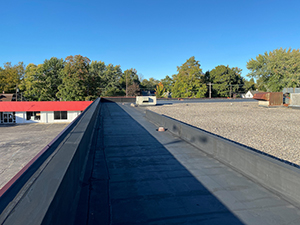
When it comes to modern roofing options, rubberized roofing systems have become an increasingly popular choice for both residential and commercial properties in Ontario, Ohio. Known for their durability, flexibility, and cost-effectiveness, these systems offer excellent protection against the elements, making them a smart investment for a wide range of building types. Our team at First Class Roofing can help! Call us today on 888-699-9321.
What is a Rubberized Roofing System?
Rubberized roofing, often referred to as EPDM roofing (Ethylene Propylene Diene Monomer), is a type of single-ply membrane roofing material made primarily from synthetic rubber. EPDM has been a trusted roofing material for decades, thanks to its resilience and ease of installation. In addition to EPDM, newer rubberized coatings and liquid-applied rubber roofing systems are also gaining popularity for their seamless application and waterproofing abilities.
Rubberized systems are particularly common on flat and low-slope roofs, where traditional shingles are less effective.
Benefits of Rubberized Roofing

Durability
Rubberized roofs are incredibly tough. EPDM membranes can last 30 to 50 years when properly installed and maintained. They are resistant to UV radiation, ozone, and extreme temperature fluctuations, making them ideal for a variety of climates.
Flexibility
Rubber roofing materials are flexible even in freezing temperatures. This flexibility helps the roof expand and contract with changing weather without cracking or splitting — a common problem with more rigid roofing materials.
Waterproofing
Rubberized systems provide exceptional waterproofing. They can easily be installed with minimal seams, and even when seams are required, special adhesives or tapes create watertight seals that protect the building underneath.
Cost-Effectiveness
Compared to other roofing systems, rubber roofing is relatively affordable, both in material cost and labor. It also requires less frequent repairs, contributing to lower long-term maintenance expenses.
Eco-Friendliness
Many rubber roofs are made from recycled materials and are themselves recyclable at the end of their life. Additionally, reflective rubber coatings can improve a building’s energy efficiency by reducing cooling costs.
Easy Installation and Repair
Rubberized roofing can be installed quickly, often in large sheets that cover substantial areas with few seams. When repairs are needed, they are generally simple — patch kits and liquid rubber solutions can address leaks or minor damage without extensive labor.
Applications for Rubberized Roofing
Rubberized roofing systems are widely used in various sectors:
- Commercial Buildings: Especially those with flat or low-sloped roofs.
- Residential Homes: Popular for extensions, garages, and flat-roofed areas.
- Industrial Facilities: Where chemical resistance and heavy durability are essential.
- Green Roof Systems: As a base membrane underneath soil and plantings.
Maintenance Tips for Rubberized Roofs
Although rubber roofs are low-maintenance, regular inspections can extend their lifespan significantly:
- Inspect for debris: Remove leaves, branches, and dirt that can trap moisture.
- Check seams and flashing: Ensure all connections remain tight and watertight.
- Look for punctures or tears: Address small issues promptly to prevent larger leaks.
- Clean the surface: Periodic washing helps maintain the material’s integrity and appearance.
Rubberized Roofing Systems Specialists
To learn more about how rubberized roofing systems may benefit your Ontario, OH commercial investment, call 888-699-9321 today and speak with an expert.
FAQ
Is rubber roofing expensive?
Rubber roofing is generally more affordable than many other commercial and flat roofing options. Installation and maintenance costs are typically lower, making it a cost-effective long-term investment.
Can a rubber roof be installed over an existing roof?
Yes, in many cases. A rubber roof can sometimes be installed over an existing roof (such as an old asphalt roof) after proper inspection and preparation. However, local building codes and the condition of the existing roof must be considered.
Is rubber roofing eco-friendly?
Yes. Many rubber roofing products are made from recycled materials and are fully recyclable. Additionally, the energy savings from reflective rubberized coatings can help reduce a building’s overall carbon footprint.
How do you maintain a rubber roof?
Maintenance is simple:
- Clear debris regularly
- Inspect seams, edges, and flashing annually
- Clean the roof surface periodically
- Address any punctures, tears, or signs of wear quickly
Professional inspections twice a year are highly recommended to catch small issues before they worsen.
What climates are best for rubberized roofing systems?
Rubber roofing performs well in all climates, from extreme cold (it remains flexible) to intense heat (resists cracking and UV degradation). It is also an excellent choice for areas with heavy rain or frequent freeze-thaw cycles.
Will a rubber roof puncture easily?
Rubber roofing is highly durable, but sharp objects or heavy foot traffic can cause punctures. Proper installation, protective walkways (on high-traffic areas), and careful maintenance help prevent damage.